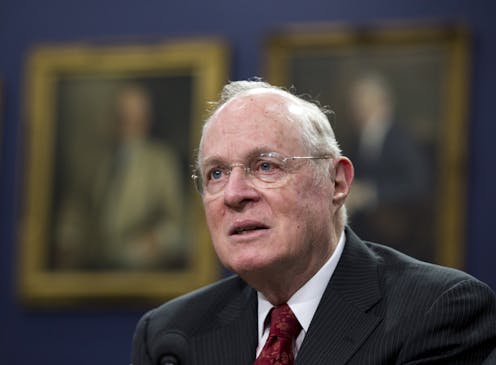Trump's choice to replace Justice Kennedy will likely be a white man, like his other court nominees
- Written by Rorie Solberg, Associate Professor of Political Science, Oregon State University

Justice Anthony Kennedy announced on June 27[1] that he will retire from the U.S. Supreme Court, giving President Donald Trump the opportunity to appoint a second justice.
Trump has stated that he will choose from the same list of 25 individuals[2] to replace Kennedy that he used after Justice Antonin Scalia died. On that list of potential nominees, all but three individuals are white and 76 percent are male.
This lack of diversity is reflective of Trump’s nominees to the federal bench.
Trump and his Republican allies in the Senate are pushing through[3] nominations for federal judges at an unusually fast pace ahead of the 2018 midterm elections. That’s when the GOP could lose its majority[4] and end the easy path to confirmation for Trump’s nominees. And Trump is expected to name his Supreme Court nominee within a week.
As political scientists who study diversity[5] and the federal bench, we keep an eye on nominations and confirmations. As of early June, Trump had the opportunity to fill 216 vacant seats out of 890, or almost 25 percent of the entire federal bench. There is no question: His appointments will move the courts ideologically to the right. About 39 percent of his nominees are replacing Democratic appointees.
We also find that Trump is in the process of producing a substantially more conservative and less diverse[6] federal bench, in terms of race and gender.
Diversity is critical to the court’s legitimacy. Put simply, people tend to view diverse institutions[7] as more fair, accessible and open. The less the face of the judiciary reflects the diversity of the nation, the more difficult it is for the courts to maintain their legitimacy.
Reversing a trend
Trump is nominating men and women who share his conservative philosophy. These nominees are vetted[8] by the Federalist Society[9], a conservative legal advocacy group, to ensure they have appropriate conservative credentials and jurisprudence[10].
This is certainly vexing to Democrats, but not unusual. President Barack Obama did the same thing[11] – picking men and women for the bench that were in his ideological mold, as did most presidents before him.
Additionally, Trump’s nominees are significantly less diverse than those of other recent presidents. Our last three presidents have valued diversity and appointed significant numbers of women and people of color. This trend still held true even while Democrat and Republican presidents were appointing ideologically aligned judges. President Trump is reversing this trend and as a result, the bench is becoming more white and more male.
Just how different are Trump’s nominees than those of previous presidents?
Using data from the Federal Judicial Center[12], the U.S. courts’ data on judicial vacancies[13] and Judicial Selection materials[14] from the progressive legal advocacy group Alliance for Justice[15], we took a look at the numbers.
By the numbers
Diversity in this context means the nomination of women or people of color to the federal bench. For example, three of Trump’s confirmed judges who identify as Asian-American or Pacific Islander replaced an outgoing white judge. Those three – James Ho, John Nalbandian and Amul Thapar – add racial diversity to the bench. Only eight of Trump’s 39 confirmed judges added racial or gender diversity. We do not include members of the LGBTQ+ community or those who self-identify as disabled here because President Trump’s nominees do not include anyone who identifies as either LGBTQ+ or disabled.
In most other instances, the replacement matches the makeup of the outgoing judge or maintains the same level of diversity. For example, Karen Scholer, a woman who identifies as Asian American/Pacific Islander, replaced Jorge Solis, a man who identifies as Latino.
In eight cases, Trump’s judge actually reduced the diversity on the bench. For example, Gregory Katsas, a white male, replaced Janice Rogers Brown, a black woman.
Overall, Trump’s judges are not diverse. Three-quarters of Trump’s confirmed judges are male, and almost 90 percent are white. The outgoing judges – appointees of Democratic and Republican presidents, Carter through Obama – are actually a slightly more diverse lot.
Trump’s confirmed judges are only a small subset of all his nominees. However, they are a representative sample. Thus far, 90 percent are white and 77 percent are male. And only 19 of the 119 nominations he has made so far – confirmed and pending – add diversity to the bench, while 26 reduce diversity.
Trump’s legacy
Judges hold their positions for life. Since the average age of Trump’s confirmed judges is 51, it is likely that most of his judges will serve for at least 15 to 20 years.
Barring a Democratic wave of wins in the 2018 midterms, it seems likely that a more conservative and less diverse federal bench will be one legacy of the Trump administration. In nominating conservative judges, Trump is following long-standing tradition. By discounting diversity, Trump is casting aside yet another presidential norm.
References
- ^ announced on June 27 (www.cnn.com)
- ^ 25 individuals (www.cbsnews.com)
- ^ are pushing through (thehill.com)
- ^ lose its majority (www.npr.org)
- ^ study diversity (heinonline.org)
- ^ substantially more conservative and less diverse (www.washingtonpost.com)
- ^ people tend to view diverse institutions (www.tandfonline.com)
- ^ nominees are vetted (thehill.com)
- ^ Federalist Society (fedsoc.org)
- ^ conservative credentials and jurisprudence (www.nytimes.com)
- ^ did the same thing (www.washingtonpost.com)
- ^ Federal Judicial Center (www.fjc.gov)
- ^ data on judicial vacancies (www.uscourts.gov)
- ^ Judicial Selection materials (www.afj.org)
- ^ Alliance for Justice (www.afj.org)
Authors: Rorie Solberg, Associate Professor of Political Science, Oregon State University


